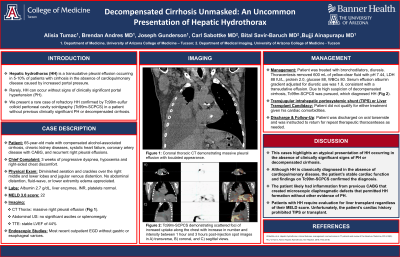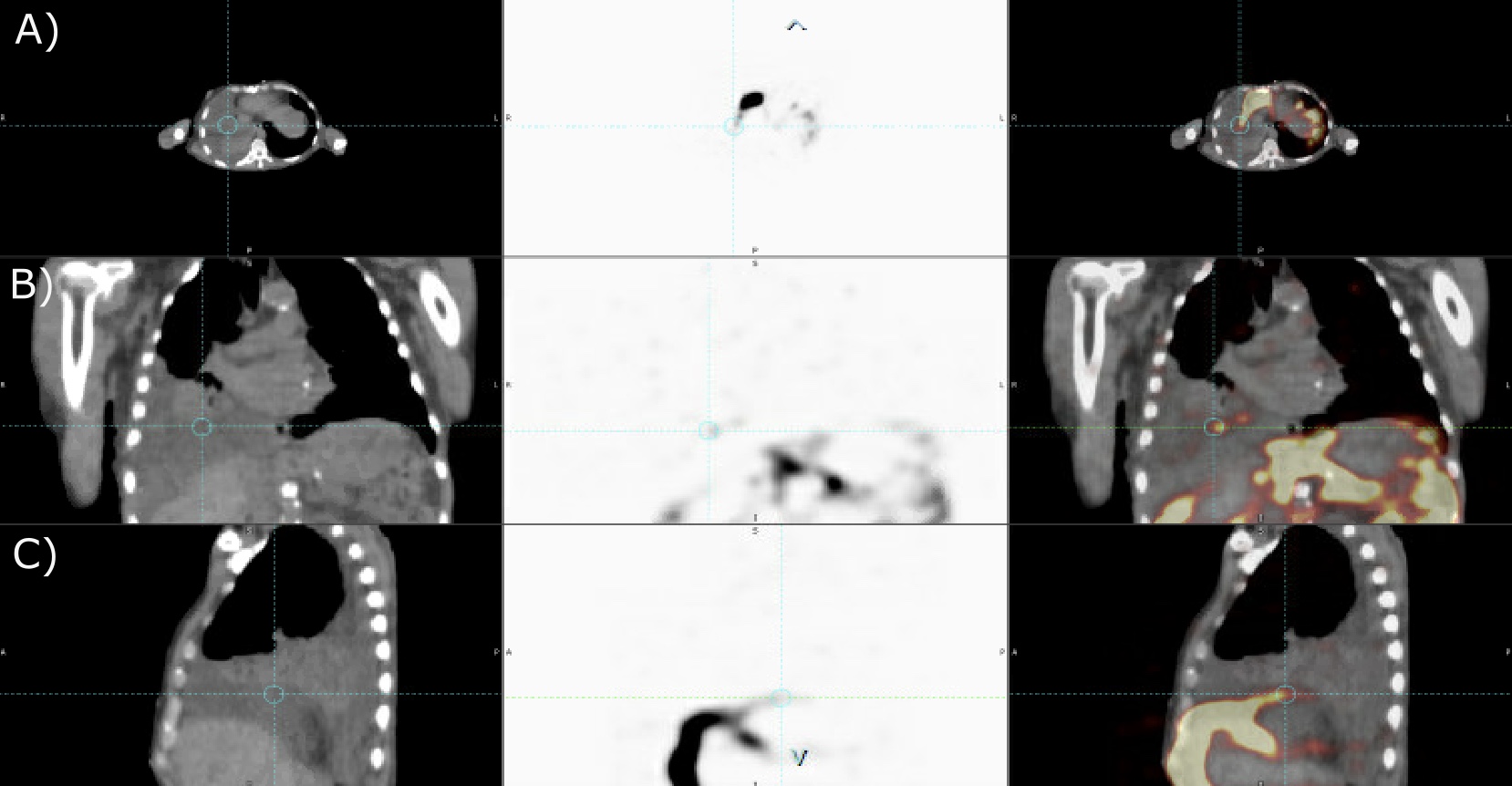Sunday Poster Session
Category: Liver
P1283 - Decompensated Cirrhosis Unmasked: An Uncommon Presentation of Hepatic Hydrothorax
Sunday, October 27, 2024
3:30 PM - 7:00 PM ET
Location: Exhibit Hall E

Has Audio

Alisia C. Tumac
University of Arizona College of Medicine
Tucson, AZ
Presenting Author(s)
Alisia C. Tumac, 1, Brendan Andres, MD2, Joseph Gunderson, 1, Carl Sabottke, MD3, Bital Savir-Baruch, MD4, Bujji Ainapurapu, MD1
1University of Arizona College of Medicine, Tucson, AZ; 2University Hospitals Cleveland Medical Center, Case Western Reserve University, Cleveland, OH; 3Banner - University of Arizona, Tucson, AZ; 4University of Arizona, Tucson, AZ
Introduction: Hepatic hydrothorax (HH) is a transudative pleural effusion caused by increased portal pressure in decompensated cirrhosis (DC). Rarely, HH occurs without signs of clinically significant portal hypertension (CSPH). We present a rare case of refractory HH confirmed by Tc99m-sulfur colloid peritoneal cavity scintigraphy (Tc99m-SCPCS) in a patient without previous CSPH or DC.
Case Description/Methods: A 65-year-old man with compensated alcohol-associated cirrhosis, chronic kidney disease, systolic heart failure, and coronary artery disease with coronary artery bypass grafting (CABG) presented with acute dyspnea and hypoxemia from a recurrent right-sided pleural effusion. Imaging and endoscopic workup revealed a massive right-sided, transudative pleural effusion, stable left ventricular ejection fraction of 44%, and no ascites, splenomegaly, or gastrointestinal varices. Liver enzymes, platelet count, and INR were normal. MELD 3.0 score was 22. Due to high clinical suspicion of initial decompensation of cirrhosis that would necessitate a transplant evaluation, Tc99m-SCPCS was pursued which diagnosed HH. Unfortunately, the patient was not a transjugular intrahepatic portosystemic shunt (TIPS) or liver transplant candidate due to medical comorbidities. He was discharged on oral torsemide and repeat therapeutic thoracenteses as needed.
Discussion: Our case highlights an atypical presentation of HH without other evidence of CSPH. HH is a transudative pleural effusion that occurs in 5-10% of patients with cirrhosis in the absence of cardiopulmonary disease, with only a fraction of cases lacking ascites. (1) HH results from ascitic fluid entering the chest via diaphragmatic defects and is confirmed via pleural fluid analysis or Tc99m-SCPCS. (Figure 1) Management includes sodium restriction, diuresis, and TIPS or liver transplant. Patients with HH require liver transplant evaluation regardless of MELD score. Diagnosing HH is likewise vital in patients with previously well-compensated cirrhosis. Tc99m-SCPCS is an effective test to confirm clinical suspicions when other evidence of CSPH remains absent despite thorough evaluation. We suspect that inflammation from the patient’s previous CABG likely created microscopic diaphragmatic defects that permitted HH formation without other evidence of CSPH. Tc99m-SCPCS proved essential in diagnosing HH and qualifying the patient for a liver transplant evaluation.
1. Lv Y, et al. Hepatic Hydrothorax. Ann Hepatol. 2018;17(1):33-46.

Disclosures:
Alisia C. Tumac, 1, Brendan Andres, MD2, Joseph Gunderson, 1, Carl Sabottke, MD3, Bital Savir-Baruch, MD4, Bujji Ainapurapu, MD1. P1283 - Decompensated Cirrhosis Unmasked: An Uncommon Presentation of Hepatic Hydrothorax, ACG 2024 Annual Scientific Meeting Abstracts. Philadelphia, PA: American College of Gastroenterology.
1University of Arizona College of Medicine, Tucson, AZ; 2University Hospitals Cleveland Medical Center, Case Western Reserve University, Cleveland, OH; 3Banner - University of Arizona, Tucson, AZ; 4University of Arizona, Tucson, AZ
Introduction: Hepatic hydrothorax (HH) is a transudative pleural effusion caused by increased portal pressure in decompensated cirrhosis (DC). Rarely, HH occurs without signs of clinically significant portal hypertension (CSPH). We present a rare case of refractory HH confirmed by Tc99m-sulfur colloid peritoneal cavity scintigraphy (Tc99m-SCPCS) in a patient without previous CSPH or DC.
Case Description/Methods: A 65-year-old man with compensated alcohol-associated cirrhosis, chronic kidney disease, systolic heart failure, and coronary artery disease with coronary artery bypass grafting (CABG) presented with acute dyspnea and hypoxemia from a recurrent right-sided pleural effusion. Imaging and endoscopic workup revealed a massive right-sided, transudative pleural effusion, stable left ventricular ejection fraction of 44%, and no ascites, splenomegaly, or gastrointestinal varices. Liver enzymes, platelet count, and INR were normal. MELD 3.0 score was 22. Due to high clinical suspicion of initial decompensation of cirrhosis that would necessitate a transplant evaluation, Tc99m-SCPCS was pursued which diagnosed HH. Unfortunately, the patient was not a transjugular intrahepatic portosystemic shunt (TIPS) or liver transplant candidate due to medical comorbidities. He was discharged on oral torsemide and repeat therapeutic thoracenteses as needed.
Discussion: Our case highlights an atypical presentation of HH without other evidence of CSPH. HH is a transudative pleural effusion that occurs in 5-10% of patients with cirrhosis in the absence of cardiopulmonary disease, with only a fraction of cases lacking ascites. (1) HH results from ascitic fluid entering the chest via diaphragmatic defects and is confirmed via pleural fluid analysis or Tc99m-SCPCS. (Figure 1) Management includes sodium restriction, diuresis, and TIPS or liver transplant. Patients with HH require liver transplant evaluation regardless of MELD score. Diagnosing HH is likewise vital in patients with previously well-compensated cirrhosis. Tc99m-SCPCS is an effective test to confirm clinical suspicions when other evidence of CSPH remains absent despite thorough evaluation. We suspect that inflammation from the patient’s previous CABG likely created microscopic diaphragmatic defects that permitted HH formation without other evidence of CSPH. Tc99m-SCPCS proved essential in diagnosing HH and qualifying the patient for a liver transplant evaluation.
1. Lv Y, et al. Hepatic Hydrothorax. Ann Hepatol. 2018;17(1):33-46.

Figure: Figure 1. Tc99m-sulfur colloid peritoneal cavity scintigraphy demonstrating scattered foci of increased uptake along the chest in A) transverse, B) coronal, and C) sagittal views.
Disclosures:
Alisia Tumac indicated no relevant financial relationships.
Brendan Andres indicated no relevant financial relationships.
Joseph Gunderson indicated no relevant financial relationships.
Carl Sabottke: Chosen Diagnostics – Intellectual Property/Patents.
Bital Savir-Baruch: Blue Earth diagnostics – Grant/Research Support. Curium – Consultant. General Electric – Consultant. Novartis – Consultant.
Bujji Ainapurapu indicated no relevant financial relationships.
Alisia C. Tumac, 1, Brendan Andres, MD2, Joseph Gunderson, 1, Carl Sabottke, MD3, Bital Savir-Baruch, MD4, Bujji Ainapurapu, MD1. P1283 - Decompensated Cirrhosis Unmasked: An Uncommon Presentation of Hepatic Hydrothorax, ACG 2024 Annual Scientific Meeting Abstracts. Philadelphia, PA: American College of Gastroenterology.
